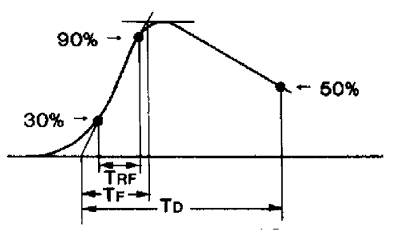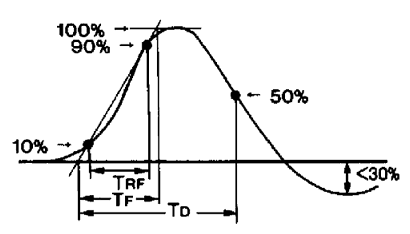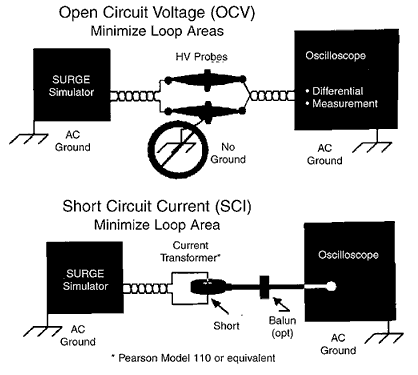Surge Test IEC 61000-4-5
Surges occur on the AC power mains as a result
of switching operations in the power grid and from nearby lightning strikes,
either directly to the power distribution system or to nearby ground. Radiated
coupling of surges into I/O lines generally occurs only when the lines are very
long.
Electronic products are tested for Surge
immunity to insure their continued reliable operation if subjected to realistic
levels of surge voltages. The European Union's EMC Directive currently mandates
Surge testing for some products; however, it is expected that virtually all
electrical and electronic products will have to be tested for Surge immunity in
the near future as a condition for obtaining the CE Mark before shipping
products to a member state of the European Union.
Applicable Standards
Generic Immunity, Product and Product Family
Standards require Surge tests be performed in accordance with Basic EMC
Standards: IEC 801-5, IEC 61000-4-5 or EN 61000-4-5. Application
Note, EMC Standards Overview, provides an overview of European Standards for
electromagnetic compatibility, describes how the Standards relate to one
another, and lists sources for procuring copyrighted documents.
Basic EMC
Standard
The Basic EMC Standard for Surge defines
the methods of generating consistently reproducible surge voltages for test
purposes. They specify generator and coupler/decoupler design and performance in
sufficient detail to produce correlatable results between test sites. While the
Basic EMC Standard specifies how to perform Surge testing, the Generic, Product
and Product Family Standards specify the test levels and pass/fail performance
criteria.
Test Levels
|
Standard |
Applicability |
Common Mode |
Differential Mode |
|
EN 50082-1 |
Generic Immunity - Residential,
Commercial and Light Industrial |
N/A |
N/A |
EN 50082-1
Draft |
Generic Immunity - Residential,
Commercial and Light Industrial |
2kV |
1kV |
|
EN 50082-2 |
Generic Immunity - Industrial
Environment |
N/A |
N/A |
|
EN 50082-2Draft |
Generic Immunity - Industrial
Environment |
4kV |
2kV |
|
EN 55104 |
Immunity for Household
Appliances, Tools and Similar Apparatus |
2kV |
1kV |
Safety

When performing Surge tests, safety is a primary
concern. Surge voltages and currents must be contained to insure they will not
appear where they can cause damage to other instruments in the test area. The
test pulses used for Surge testing are of sufficient energy to cause components
to fragment under fault conditions and become hazardous to personnel in
unprotected environments.
Coupling Methods
Capacitive Coupling via
9pF (Line to earth) or 18pF (line to line) capacitors is required for coupling
surges to AC or DC power mains. These coupling capacitors are typically included
as part of a Coupler/Decoupler (C/D) in commercially available Surge simulators.
The C/D provides both coupling to the EUT power mains and a decoupler to prevent
the surge from appearing on the ac mains connected to other equipment in the
lab.
Capacitive Coupling via .5pF capacitors, as well as via alternative
devices such as surge arrestors, are used to couple surges onto data, I/O and
telecommunication lines. Surge arrestors are the preferred coupler device due to
the undesirable loading effects of capacitors particularly at frequencies
greater than a few kilohertz. A decoupler is included to prevent the surge from
appearing at, and potentially damaging, the auxiliary equipment.
Waveforms

Open Circuit Voltage 1.2 x 50 Front Time: TF
= 1.67 x TRF = 1.2µsec ± 30%
Duration: TD = Virtual Start to 50% = 50µsec
±20% |

Short Circuit Current 8 x 20 Front Time: TF =
1.25 x TRF = 8µsec ± 30%
Duration: TD = Virtual Start to 50% = 20µsec
±20% |
Waveform Verification
IEC 61000-4-5 requires that the simulator output
be verified periodically. High voltage differential surge probes are required
for verifying the open-circuit voltage, and a suitable current transformer
(Pearson Model 110 or equivalent) is required for verification of the
short-circuit current. A digital or storage oscilloscope with 100MHz bandwidth
is sufficient for measuring the surge voltage and current waveforms and peaks.

Test Execution
According to IEC 61000-4-5, testing must be
carried out according to the manufacturer's test plan, which shall specify:
Generator & other equipment.
Generator Source Impedance.
Repetition rate (one per minute maximum).
Sequence of application of the surge.
Installation conditions.
Operating conditions of EUT.
Number of tests (at least five positive and five negative at each point).
Test levels.
Polarity.
Inputs/outputs tested.
Phase angle of coupling to ac mains.
Internal or external trigger.
EUT Performance Criteria
For Surge tests, the Generic Immunity Standards
and Household Appliances Product Family Standard require that products operate
as intended after the test. No degradation or loss of function is allowed below
a performance level specified by the manufacturer. During the test, degradation
is allowed, but not a change in the actual operating status or data storage.
Refer to the tables located in the Generic, Product and Product Family Standards
for specific Performance Criteria. The product cannot become unsafe under any
conditions.
Surge Simulators
Surge Simulators produced by Thermo KeyTek meet
all the simulator requirements of IEC 61000-4-5, including dynamic source
impedance, all waveform characteristics, and couplSurge Simulators produced by Thermo KeyTek meet
all the simulator requirements of IEC 61000-4-5, including dynamic source
impedance, all waveform characteristics, and coupler/decoupler design.
|

